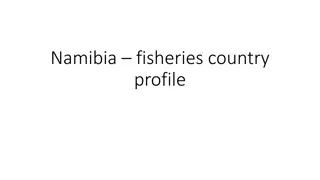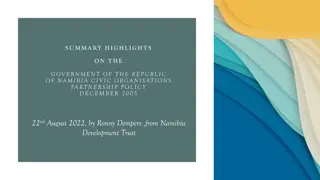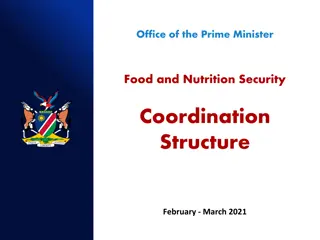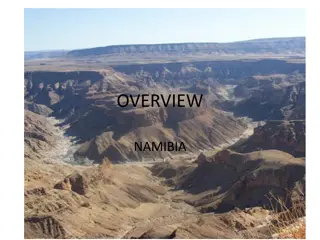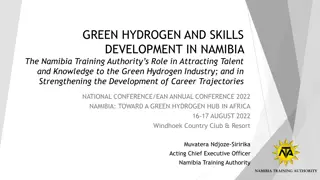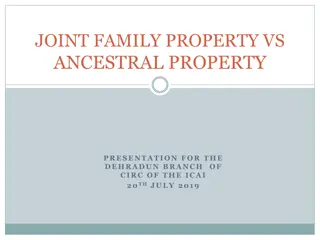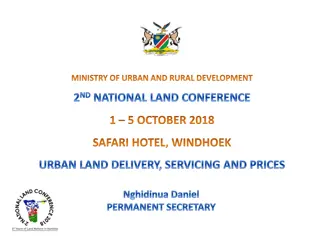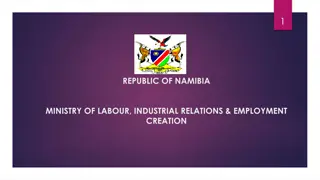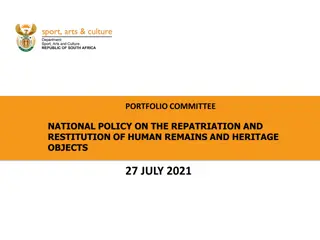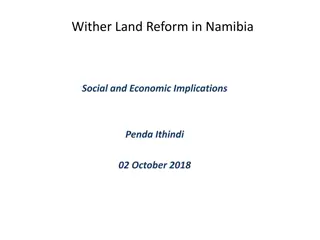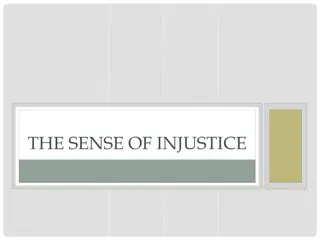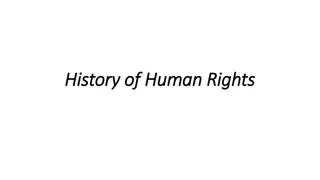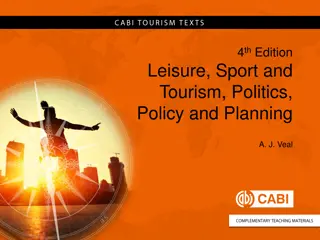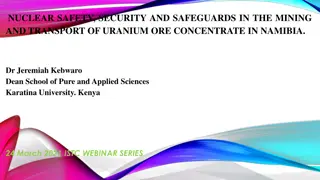Namibia's Ancestral Land Rights: Historical Injustice and Restitution
Explore the historical context of land ownership in Namibia, focusing on ancestral land rights, colonization processes, and the impact on indigenous populations. Learn about the notion of ancestral land, who should be considered indigenous, and the colonial modes of land acquisition. Uncover the struggles for restitution and the ongoing efforts to address historical injustices.
Download Presentation

Please find below an Image/Link to download the presentation.
The content on the website is provided AS IS for your information and personal use only. It may not be sold, licensed, or shared on other websites without obtaining consent from the author. Download presentation by click this link. If you encounter any issues during the download, it is possible that the publisher has removed the file from their server.
E N D
Presentation Transcript
Historical Perspective, Injustice and Land Ownership Pattern in Namibia A Thematic Presentation on Ancestral Land Rights & Restitution
What is Ancestral land? The notion of ancestral land rights has in recent years been given currency by the adoption of the United Nations Declaration on the Rights of Indigenous People (UNDRIP). The 2007 Advisory Opinion of the ACHPR defined the ancestral land in reference to a special attachment to and use of their traditional land and territory have a fundamental importance for their collective and physical and cultural survival as people. Namibia signed the UNDRIP on September 13, 2007 and have developed a Draft Paper on the Right of Indigenous People in Namibia.
Who should be considered indigenous? The ACHPR Advisory Opinion: in Africa, the term indigenous populations does not mean first inhabitant, in reference to aboriginality as opposed to non African communities or those having come from elsewhere. This peculiarity, distinguishes Africa from the other Continents where native communities have been almost annihilated by non native populations. Therefore, the ACHPR considered that any African can legitimately consider him/herself as indigene to the Continent
Processes & Experiences of Colonization As process was the invasion, conquest and direct administration of the territories, peoples and communities by European colonial powers. A generic term subsuming a vast variety of historical situations, experiences and legacies both between and within colonies indirect rule coined by Lord Lugard the British soldier, mercenary, explorer of Africa and colonial administrator Direct rule Settler colonialism
SOME SNAPSHOTS ON THE HISTORICAL CONTEXT
Prior to Colonization The laws in force in various communities were based on evolutionary customary legal systems.
Colonial modes of land acquisition (1884 - 1902) Namibia was declared a German colony in 1884. Pre 1894 - trade facilitation between the indigenous land and cattle owners and the German merchandise traders.
Primary Resistance Post 1894 changed colonial policy outlook presupposed Transfer of 75 % of the African land to European settlers, the remainder to be proclaimed native reserves. This became the primary source of tension
The Genocidal Effects of Germanys Scorched Earth Colonial Environmental Warfare The 1905 Kaiser s Proclamation gave the German colonial state total control over both: The rangelands of southern and central Namibia. Melber (2000) by 1914 Close to 12 500 Africans survivors of the war were forced to work as cheap labourers on European farms. Another 10 000 worked on large scale mining and government project across the country. Only as little as 200 men from both the Nama and Ovaherero communities were outside the formal relations of employment.
THE STORY OF KALEB HANGANEE TJIPUAHURA (DAY BY DAY)
Joined SWAPO in 1962, went for military training, and returned to Namibia as Commander of the G3, where he was captured by South African forces in 1966. Charged and tried with other Namibian in the Pretoria Terrorism Trial from September 1967 to February 1968. Sentenced to life imprisonment on Robben Island. He was released in 1985, after serving close to 18 years. Died at Windhoek on 10.04.1987 from complications of kidney ailments, contracted during his imprisonment.
Kaleb Hanganee Tjipuahura (Day by Day) In his book Odyssey to Freedom George Bizos, the South African human lawyer who represented many of the Robben Island prisoners during their respective trials remembered him with these words: Tall Herero s grandfather had been a rare survivor of the German army genocide campaign against the Herero some seventy year earlier. He had fled to the then Bechuanaland Protectorate. Tall left school to join SWAPO and undergo military training partly to avenge the wrong done to his family and people, and partly in hope that he would one day return to an independent Namibia to claim the ancestral land his grandfather spoke of, which were now occupied by the Boers. He had also joined other armed were lives were lost. There were many witnesses to prove his guilt
Kaleb Hanganee Tjipuahura (Day by Day) Bizos went further He [Tjipuahura] prcloaimed that he knew that he was going to die. He understood that it would be freedom or death when he joined the struggle. Having lost his freedom it was better to die than to be jailed for life. He knew his case was hopeless, but he thanked the defence team for its effort and urged it to work on the case of those who had chance of being acquitted or receiving lighter sentences
South African Colonial Rule The repatriation of +/- 6 000 German soldiers and other colonial officials back to Germany. General Botha s earlier hallow and empty promises to hand back the lands and stock to the rightful owners. A senior South African official in 1922 reported to the League of Nations: almost without exception each section asked for the allotment of the old tribal areas in which vested right had accrued and the utmost difficulty was experienced in making them realize the utter impossibility of complying with such a request . (Vigne,1975)
The South African Native Trust and Land Act (Act 27 of 1913) Became applicable to the territory in 1920, and later provided the scope for the 1922 Native Administration Proclamation provided for: separate settlement areas for people of different races, effectively prohibited land transactions between blacks and whites. Prohibition of natives in employment from being permitted to squat on or lease land designated for whites without permission of magistrate. Prohibition of farmers from employing more than ten black African families without the special permission of the local magistrate The 1922 recommendation of the Native Reserves Commission to serve only 10% of the land in southern and central Namibia for the indigenous communities to live on The establishment of the: Land Board to facilitate the large scale settlement and relocation of South African farmers. Land Bank similar to that which existed in the Union in 1921.
New Waves of Colonial Dispossession Emmett (1987) the settlement of 830 settlers were resettled on 662 farms comprising of more than 5.6 million hectares (1920 1923). The findings of the General Rehabilitation Commission On the social security for all European persons living in South West Africa and the shifting of the boundaries of the Police zone and the Sperrgebiet diamond area in 1950, which made a further 275 farms available The reversal in 1932of the status of Aukeigas 20 km west of Windhoek, previously proclaimed by the German colonial administration in 1907, to pave the way for the enlargement the Daan Viljoen Nature Park (proclaimed a conservation area in 1972). Resulted in the forceful removal of the original Damara speaking inhabitants in three stages: first to Okombahe in 1938 and in 1941 and then finally to Sorris Sorris in 1958.
The Effects and Responses to the Native Reserves Policy The creation native reserves with sizes close to 800 000 hectares of the same Omaheke (sandveld) for reserves. The protestation Chief Hosea Kutako a desert where no human being ever lived before It is a country only good for wild beast We are the original inhabitants of South West Africa We know the parts which are good for cattle, we know the parts which are good for wild beast. We are human being and we do not want to change into wild beast .
The Effects and Responses to the Native Reserves Policy Odendaal Commission s recommendations for the homeland of Damaraland, bordering the Namib Desert to the west, on 223 commercial farms purchased after being abandoned by their previous white farmers, because of the volatility of its environmental conditions. Concerns expressed by Pastor Paulus Gowaseb of the Lutheran Evangelical Church, aed to the South African Prime Minister, more than 40 000 of my people are still left who live in the whole of [SWA] and that since time immemorial. Various places in [SWA] are their homes. But now we are made into strangers in the country of our birth and are left no right there. The purpose is that we should all move to the homeland which is a strange place for the majority and where they do not know how they should live People may certainly move into the area, but no one may come out again except as contract labourers and not without permits
SNAPSHOTS ON THE UNFINISHED BUSINESS FROM THE 1STNATIONAL CONFERENCE GRAPPLED WITH
Enduring Bequeathed Legacy 1: Perpetual Impoverishment UNIN, 1985 The denial of the African of his/her property rights and other related aspirations of the black people for the equitable access to fertile land and good pasture, have resulted in their perpetual impoverishment.
Enduring Bequeathed Legacy 2: Income and Wealth Inequalities Tapscott, 1993 The private ownership by some 4,045 white commercial farmers of some 45 per cent of the total land area and 74 per cent of the potentially arable land, became a major factor in determining inequality of income and wealth
Enduring Bequeathed Legacy 3: Over concentrated Land Ownership A 1976 study cited in the UNIN (1985) Absentee landlords48% of commercial farms were owned by, who visited it at intervals, while leaving the day to day operations and management in the hands of white local supervisors. The over-concentrated agricultural land ownership structure, estimated at close to 40% of the commercial farms in the eastern cattle rearing district of Gobabis were owned by 16% of the area s farmers in the early 1970 s. NSA (September 2018) previously advantaged Namibian own 70% (or 27.8 million hectares) of freehold agricultural land, compared to only 16% (or 6.4. million hectares) by the previously disadvantaged
Enduring Bequeathed Legacy 4: Overcrowding and Overgrazing Uazuva Kaumbi (2004) The Otjohorongo Native Reserve came into existence when the South African colonial administration purchased 55 farms totalling 270 000 km from its previous white owners. By the year 2000 this area was inhabited by close to 10 000 people, who jointly owned 11 769 herds of cattle, 58 201 goats and sheep, 2420 horses and donkey. This epitomizes the critical conditions of overcrowding and overgrazing, which has had not only a tremendously negative impact on the natural environment, but also on the livelihoods of its inhabitants.
Ancestral Rights: Resolution 2 of the 1STNational Land Conference Before Namibia was colonized at the end of the 19thcentury, the land boundaries between Namibian communities were not precisely demarcated and shifted frequently. The claims of different communities will inevitably overlap. During the colonial period, there have been large population movements and a mixing of previously distinct communities. The conference concludes that given the complexities in redressing ancestral land claims, restitution of such claims in full is impossible (OPM, 1991, pp. 23 24)
SNAPSHORTS ON CONCERNS & POTENTIAL CONSTRAINTS
Overlapping Boundaries and the Prospects for Conflicting Claims Look into the establishment of a Ancestral Land Tribunal, as recommended in the NANGOF Consultation Findings on Agricultural Land (September 2018).
Fear of Bantustanization The assertion of customary authority and power of ethnically based traditional authorities over land - Article 1(1) unitary state provision. Unlike Rwanda, the Namibian Constitution makes provision for the Council of Traditional There are also a number of legislation within the context of which the issue of the ancestral land rights could be dealt with Council of Traditional Leaders Act (Act No. of 1997) Traditional Authorities Act (Act No. 2000) Communal Land Act (Act No. 5 of 2002) Community Court Act (Act No. 10 of 2003)
Concerns of extra Territoriality ACHPR Advisory Opinion provide scope for dealing with this challenge Recognise that trans national identification of indigenous communities is an African reality for several of the socio ethnic groups living on our Continent and which co habit in perfect harmony with the principles of territorial integrity and national unity Ancestral land rights should be within the context of a strict respect for sovereignty, the inviolability of borders acquired at independence of the member states and respect for their territorial integrity in conformity with the principles and value enshrine in the Constitutive Act of the AU and the UN Charter .
Compatibility with Articles 10 Article 23 (2) All people shall be equal before the law Article 19 Every person shall be entitle to enjoy, practice, profess, maintain and promote any culture, language, tradition or religion subject to the terms of this Constitution and further subject to the condition that the rights protected by this Article do not impinge upon the right of others or the national interest No person shall be discriminated against on the grounds of sex, race, colour, ethnic origin, religion, creed or social or economic status
Compatibility with Articles 10 Based on ACHPR Advisory Opinion the concept of ancestral land rights is not aimed at protecting the rights of a certain category of citizens over and above others. This notion does not also create a hierarchy between national communities, but rather tries to guarantee the equal enjoyment of rights and freedoms on behalf of groups, which have been historically marginalized. Karl Emil Liljeblad a Finnish missionary - at the times of early settlement, the ownership of land by clans was largely limited to places where clan members erected their homestead, and by the extent of the land they were able to cultivate and/or graze their animals.
Some Constitutionally viable options could be: Based on Resolution of the 1stNational Land Conference Expanding the target groups stated in NRP (July 2001) Stand alone Ancestral Land Restitution Programme similar to that in South Africa. Measures of Restoration rather than restitution.
Conclusion The limitations in the current land reform policy and programmatic scope cannot and should not be used as excuses for stifling the innovative ideas for re designing the existing political and legal policy framework. Failure to build on Resolution 2 of the 1st National Land Conference, would not be due to impracticability, but lack of political will.
THANK YOU VERY MUCH FOR THE AUDIENCE





